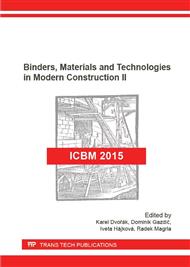p.27
p.32
p.37
p.42
p.47
p.53
p.57
p.62
p.67
Testing of Possible Use of Fine-Grained Alkali Activated Composites in the Construction Industry
Abstract:
Alkali-activated materials are formed by the alkaline activation of inorganic materials and are characterized by the wide range of potential use. The objective of experiment was to investigate the possibility of use fine-grained alkali activated composites in the construction industry. Selected properties of alkali-activated systems based on granulated blast furnace slag and fine-grained aggregates were determined. At the beginning of the experiment, different samples prepared of 3 types of activators were tested, basic properties (time of workability, initial and final setting time, compressive and flexural strength) and also a possibility of selected retarder use was determined. Then, samples with the best potencial to presumed use were tested in detail and a possibility use as a substitute for selected construction materials were evaluated. On the basis of determined properties, prepared composites could be used as reprofiling mortars, materials for cracks repairing or socle plasters.
Info:
Periodical:
Pages:
47-52
Citation:
Online since:
August 2016
Authors:
Keywords:
Price:
Сopyright:
© 2016 Trans Tech Publications Ltd. All Rights Reserved
Share:
Citation:


